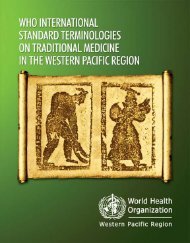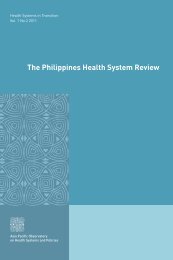Download pdf, 989kb - WHO Western Pacific Region - World Health ...
Download pdf, 989kb - WHO Western Pacific Region - World Health ...
Download pdf, 989kb - WHO Western Pacific Region - World Health ...
Create successful ePaper yourself
Turn your PDF publications into a flip-book with our unique Google optimized e-Paper software.
Sexual and Reproductive <strong>Health</strong> of Adolescents and Youths in Malaysia<br />
where knowledge was high, the fact that<br />
it was not being applied by following safe<br />
practices. Sexuality education must also<br />
be designed to ensure that knowledge<br />
can be accompanied by skills. There<br />
appears to be a good amount of teaching<br />
material, but it is not being used<br />
optimally. The proposals for sexual and<br />
reproductive health education for those<br />
outside the school system, including very<br />
young children and pre-schoolers, should<br />
also be actively pursued. It is also<br />
recommended that current educational<br />
efforts and methods be evaluated, so that<br />
weaknesses and strengths can be<br />
identified and necessary improvements<br />
made.<br />
4.3. Strengthening service<br />
provision<br />
While the Ministry of <strong>Health</strong> and several<br />
other agencies have begun to provide<br />
adolescent health services, the content<br />
emphasis is less on sexual and<br />
reproductive health and more on general<br />
health. It will require motivated health<br />
service providers to carry out sexual and<br />
reproductive health services, including<br />
counselling. However, many health<br />
providers do not have enough<br />
knowledge and skills to do so. Efforts<br />
begun by the Ministry of <strong>Health</strong> to<br />
develop modules for health providers<br />
should be continued and strengthened.<br />
<strong>Health</strong> care providers need to be aware<br />
of their own attitudes towards<br />
adolescents’ sexual and reproductive<br />
health. <strong>Health</strong> care workers will also need<br />
training in how to be sensitive to<br />
adolescents’ needs and concerns while<br />
still respecting cultural beliefs. Several<br />
reports state that services provided by<br />
the Ministry of <strong>Health</strong> are not<br />
adolescent-friendly. This is postulated to<br />
contribute to the underutilization of<br />
health services. In addition to the<br />
attitudes of service providers, the design<br />
and layout of clinics may also be<br />
discouraging young people from using<br />
them.<br />
4.4. Clarifying policies<br />
It is challenging to reconcile ideal goals<br />
with what happens in reality with respect<br />
to service provision regarding such areas<br />
as pre-marital sex and non-use of<br />
contraceptives among young people<br />
engaged in sex. Such a difficulty,<br />
however, should not be seen as an<br />
insurmountable barrier. More efforts<br />
should be made to consult with religious<br />
leaders and other community leaders. It<br />
is suggested in some of the literature that<br />
not enough effort has been made to<br />
reconcile educational and other policies<br />
with social and religious values and<br />
rulings.<br />
52

















